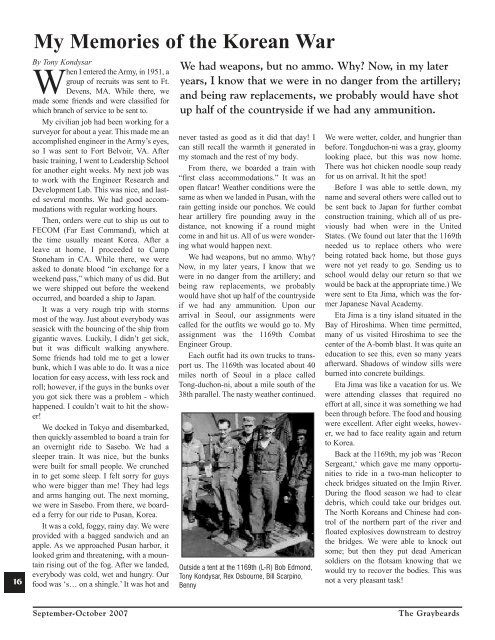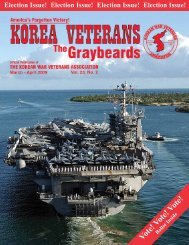The Complete Issue - Korean War Veterans Association
The Complete Issue - Korean War Veterans Association
The Complete Issue - Korean War Veterans Association
You also want an ePaper? Increase the reach of your titles
YUMPU automatically turns print PDFs into web optimized ePapers that Google loves.
16<br />
My Memories of the <strong>Korean</strong> <strong>War</strong><br />
By Tony Kondysar<br />
When I entered the Army, in 1951, a<br />
group of recruits was sent to Ft.<br />
Devens, MA. While there, we<br />
made some friends and were class ified for<br />
which branch of service to be sent to.<br />
My civilian job had been working for a<br />
sur veyor for about a year. This made me an<br />
ac complished engineer in the Army’s eyes,<br />
so I was sent to Fort Belvoir, VA. After<br />
basic train ing, I went to Leadership School<br />
for another eight weeks. My next job was<br />
to work with the Engineer Research and<br />
Development Lab. This was nice, and lasted<br />
several months. We had good accommodations<br />
with regular work ing hours.<br />
<strong>The</strong>n, orders were cut to ship us out to<br />
FE COM (Far East Command), which at<br />
the time usually meant Korea. After a<br />
leave at home, I proceeded to Camp<br />
Stoneham in CA. While there, we were<br />
asked to donate blood “in ex change for a<br />
weekend pass,” which many of us did. But<br />
we were shipped out before the weekend<br />
occurred, and boarded a ship to Ja pan.<br />
It was a very rough trip with storms<br />
most of the way. Just about everybody was<br />
seasick with the bouncing of the ship from<br />
gigantic waves. Luckily, I didn’t get sick,<br />
but it was dif ficult walking anywhere.<br />
Some friends had told me to get a lower<br />
bunk, which I was able to do. It was a nice<br />
location for easy access, with less rock and<br />
roll; however, if the guys in the bunks over<br />
you got sick there was a prob lem - which<br />
happened. I couldn’t wait to hit the shower!<br />
We docked in Tokyo and disembarked,<br />
then quickly assembled to board a train for<br />
an over night ride to Sasebo. We had a<br />
sleeper train. It was nice, but the bunks<br />
were built for small people. We crunched<br />
in to get some sleep. I felt sorry for guys<br />
who were bigger than me! <strong>The</strong>y had legs<br />
and arms hanging out. <strong>The</strong> next morning,<br />
we were in Sasebo. From there, we boarded<br />
a ferry for our ride to Pusan, Ko rea.<br />
It was a cold, foggy, rainy day. We were<br />
provided with a bagged sandwich and an<br />
ap ple. As we approached Pusan harbor, it<br />
look ed grim and threatening, with a mountain<br />
rising out of the fog. After we landed,<br />
everybody was cold, wet and hungry. Our<br />
food was ‘s… on a shingle.’ It was hot and<br />
We had weapons, but no ammo. Why? Now, in my later<br />
years, I know that we were in no danger from the artillery;<br />
and being raw re placements, we probably would have shot<br />
up half of the countryside if we had any ammu nition.<br />
never tasted as good as it did that day! I<br />
can still recall the warmth it generated in<br />
my stomach and the rest of my body.<br />
From there, we boarded a train with<br />
“first class accommodations.” It was an<br />
open flatcar! Weather conditions were the<br />
same as when we landed in Pusan, with the<br />
rain getting in side our ponchos. We could<br />
hear artillery fire pounding away in the<br />
distance, not knowing if a round might<br />
come in and hit us. All of us were wondering<br />
what would happen next.<br />
We had weapons, but no ammo. Why?<br />
Now, in my later years, I know that we<br />
were in no danger from the artillery; and<br />
being raw re placements, we probably<br />
would have shot up half of the countryside<br />
if we had any ammu nition. Upon our<br />
arrival in Seoul, our assign ments were<br />
called for the outfits we would go to. My<br />
assignment was the 1169th Combat<br />
Engineer Group.<br />
Each outfit had its own trucks to transport<br />
us. <strong>The</strong> 1169th was located about 40<br />
miles north of Seoul in a place called<br />
Tong- duchon-ni, about a mile south of the<br />
38th pa rallel. <strong>The</strong> nasty weather continued.<br />
Outside a tent at the 1169th (L-R) Bob Edmond,<br />
Tony Kondysar, Rex Osbourne, Bill Scarpino,<br />
Benny<br />
We were wetter, colder, and hungrier than<br />
before. Tongduchon-ni was a gray, gloomy<br />
looking place, but this was now home.<br />
<strong>The</strong>re was hot chicken noodle soup ready<br />
for us on arrival. It hit the spot!<br />
Before I was able to settle down, my<br />
name and several others were called out to<br />
be sent back to Japan for further combat<br />
construction training, which all of us previously<br />
had when were in the United<br />
States. (We found out later that the 1169th<br />
needed us to replace others who were<br />
being rotated back home, but those guys<br />
were not yet ready to go. Sending us to<br />
school would delay our return so that we<br />
would be back at the appropriate time.) We<br />
were sent to Eta Jima, which was the former<br />
Japan ese Naval Academy.<br />
Eta Jima is a tiny island situated in the<br />
Bay of Hiroshima. When time permitted,<br />
many of us visited Hiroshima to see the<br />
center of the A-bomb blast. It was quite an<br />
education to see this, even so many years<br />
afterward. Shadows of window sills were<br />
burned into concrete buildings.<br />
Eta Jima was like a vacation for us. We<br />
were attending classes that required no<br />
effort at all, since it was something we had<br />
been through before. <strong>The</strong> food and housing<br />
were excellent. After eight weeks, however,<br />
we had to face reality again and return<br />
to Korea.<br />
Back at the 1169th, my job was ‘Recon<br />
Ser geant,‘ which gave me many opportunities<br />
to ride in a two-man helicopter to<br />
check bridges situated on the Imjin River.<br />
During the flood season we had to clear<br />
debris, which could take our bridges out.<br />
<strong>The</strong> North <strong>Korean</strong>s and Chinese had control<br />
of the northern part of the river and<br />
floated explosives downstream to destroy<br />
the bridges. We were able to knock out<br />
some; but then they put dead American<br />
soldiers on the flotsam knowing that we<br />
would try to recover the bodies. This was<br />
not a very pleasant task!<br />
September-October 2007<br />
<strong>The</strong> Graybeards

















